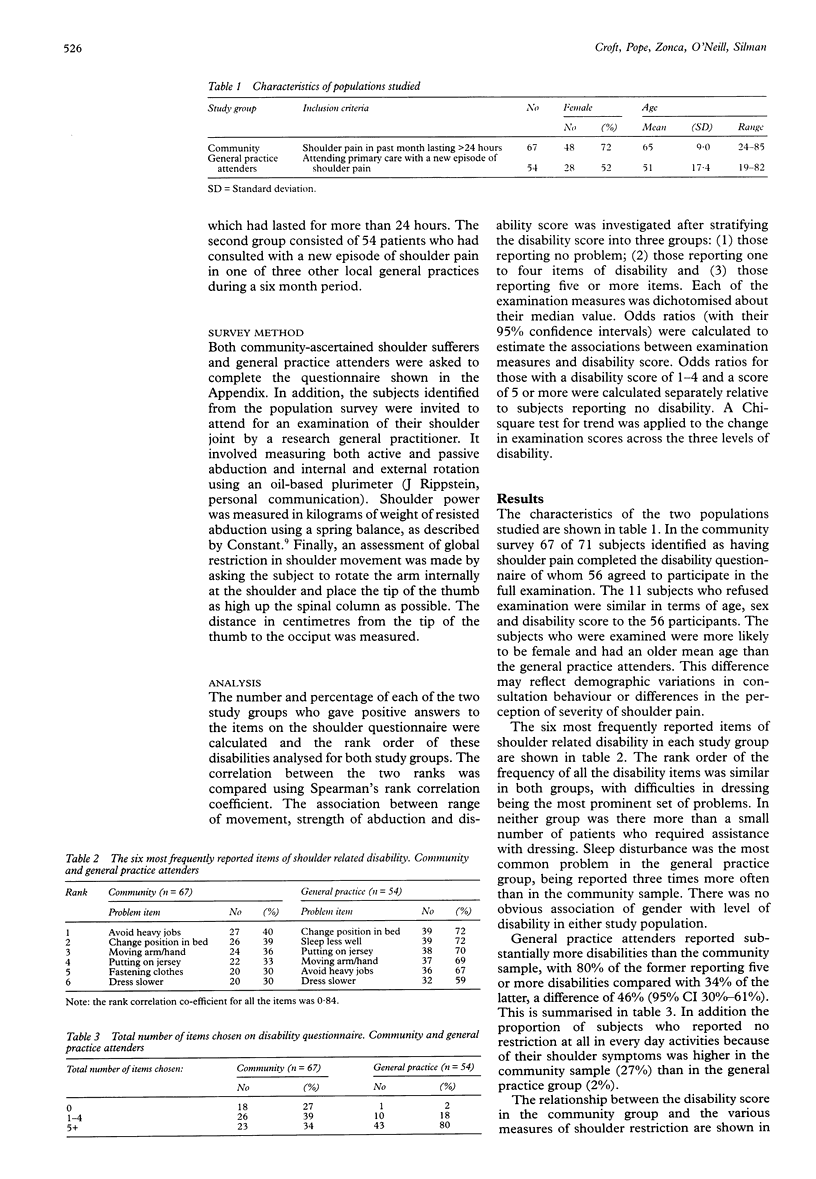Abstract
OBJECTIVE--To develop and validate a questionnaire to quantify disability associated with shoulder symptoms. METHODS--A set of questions relevant to shoulder symptoms from a general disability interview was developed and the questionnaire applied to a cross-sectional population survey and a prospective study of general practice attenders. Subjects included adults who reported current shoulder pain in a population survey and patients from three general practices who attended with shoulder symptoms during a six month period. The main outcome measures were: frequency of problems with daily living related to shoulder symptoms, total score on 22-item disability questionnaire, and measures of shoulder movement. RESULTS--A higher proportion (80%) of patients attending their general practitioner with shoulder symptoms had five or more disabilities compared with subjects reporting shoulder pain in a community survey (34%). The ranked frequency with which each disability was reported was similar in the two groups, although sleep disturbance was the most common problem in consulters. Self-reported disability is correlated with measures of restricted shoulder movement. CONCLUSION--This disability questionnaire was simple to complete and should prove useful for both general practice and population-based studies of shoulder pain.
Full text
PDF



Selected References
These references are in PubMed. This may not be the complete list of references from this article.
- Badley E. M., Tennant A. Changing profile of joint disorders with age: findings from a postal survey of the population of Calderdale, West Yorkshire, United Kingdom. Ann Rheum Dis. 1992 Mar;51(3):366–371. doi: 10.1136/ard.51.3.366. [DOI] [PMC free article] [PubMed] [Google Scholar]
- Chakravarty K. K., Webley M. Disorders of the shoulder: an often unrecognised cause of disability in elderly people. BMJ. 1990 Mar 31;300(6728):848–849. doi: 10.1136/bmj.300.6728.848-a. [DOI] [PMC free article] [PubMed] [Google Scholar]
- Constant C. R. Historical background, anatomy and shoulder function. Baillieres Clin Rheumatol. 1989 Dec;3(3):429–435. doi: 10.1016/s0950-3579(89)80002-0. [DOI] [PubMed] [Google Scholar]
- Croft P., Rigby A. S., Boswell R., Schollum J., Silman A. The prevalence of chronic widespread pain in the general population. J Rheumatol. 1993 Apr;20(4):710–713. [PubMed] [Google Scholar]
- Deyo R. A. Comparative validity of the sickness impact profile and shorter scales for functional assessment in low-back pain. Spine (Phila Pa 1976) 1986 Nov;11(9):951–954. doi: 10.1097/00007632-198611000-00017. [DOI] [PubMed] [Google Scholar]
- Jacobsson L., Lindgärde F., Manthorpe R. The commonest rheumatic complaints of over six weeks' duration in a twelve-month period in a defined Swedish population. Prevalences and relationships. Scand J Rheumatol. 1989;18(6):353–360. doi: 10.3109/03009748909102096. [DOI] [PubMed] [Google Scholar]
- Roach K. E., Budiman-Mak E., Songsiridej N., Lertratanakul Y. Development of a shoulder pain and disability index. Arthritis Care Res. 1991 Dec;4(4):143–149. [PubMed] [Google Scholar]
- Roland M., Morris R. A study of the natural history of back pain. Part I: development of a reliable and sensitive measure of disability in low-back pain. Spine (Phila Pa 1976) 1983 Mar;8(2):141–144. doi: 10.1097/00007632-198303000-00004. [DOI] [PubMed] [Google Scholar]


